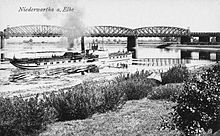Nativity scenes (ship, 1912)
|
Paddle steamer Kaiser Franz Josef in Niederlommatzsch
|
||||||||||||||||||||
|
||||||||||||||||||||
|
||||||||||||||||||||
|
||||||||||||||||||||
|
||||||||||||||||||||
The paddle steamer Krippen was built in 1912 in the Laubegast shipyard. The ship was under the name of Emperor Franz Josef with the hull number 55 in 1912 to set keel . In 1919 the third ship was named Saxonia , in 1926 the name Laubegast and in 1938 the name Krippen .
The time after commissioning until 1945


Due to the repeatedly low water level of the Elbe in summer, the Saxon-Bohemian Steamship Company (SBDG) decided to build a smooth-deck steamer with a shallow draft. It was named after Franz Joseph I, Emperor of Austria. After commissioning in 1912, it operated under this name until 1919, then as Saxonia . After the SBDG ceased operations in 1923, the ship was taken over by the Sächsisch-Böhmische Dampfschiffahrt, Aktiengesellschaft (SBDA), newly founded in 1923 . The white painting of the ships, which was customary from 1926, earned it the name White Fleet . The ship already had a steam steering engine and a wheelhouse. The steam control machine was built by the Dresdner Maschinenfabrik und Schiffswerft Uebigau AG with factory no. 1380. In size, the ship is comparable to the Pillnitz . According to today's standards, the number of passengers is likely to be around 400.

In October 1919, like all ships bearing the name of a monarch or a monarchy, she was renamed and given the name Saxonia . She was the third ship with that name. In May 1926 the name was changed to Laubegast . In the winter of 1927/28 the ship was rebuilt. The hull was lengthened by 3.66 m and the wheel arches were removed to make room for the installation of toilets. In addition to the construction of an upper deck, a deck saloon and steam heating were installed in the stern. At the same time the ship was painted white.
On July 17, 1929, the Laubegast collided with the Leitmeritz while docking in Pillnitz . A wheel arch was damaged in the process.
In February 1938, the ship was renamed Krippen .
In the summer of 1943 the cribs, like all steamers, were given a camouflage paint job. From July 29th to August 4th 1943 the ship was used for evacuation measures after the bombing raids in Hamburg. Nothing is known about their further use in World War II .
The time after 1945
In 1946 it was incorporated into the newly founded Soviet State Oderschiffahrts-AG (SOAG) and on July 3, 1946, it was confiscated as a reparation payment and transferred to the Soviet Union . In the shipyard in Roßlau or the shipyard in Aken , the superstructures and wheel arches were removed in order to be able to pass the low bridges and narrow locks on the way to Stettin . After crossing the Baltic Sea , the ship was used as a transport ship in the Leningrad area. Nothing is known about the further whereabouts.
The steam engine
The steam engine was an inclined high-pressure two-cylinder composite steam engine with injection condensation. Like the two-flame tube cylinder boiler, it was built by Dresdner Maschinenfabrik und Schiffswerft Uebigau AG with factory no. 1371. The power was 180 hp. The steam boiler had a steam pressure of 11 bar . The steam engine worked on two side paddle wheels. The steam engine was a high-speed machine with 60 instead of the usual 40 revolutions / min. Therefore, the paddle wheels were smaller than before. However, the machine did not prove itself.
Captains of the ship
- Ernst Adolf Kleinert 1913–1914
- Friedrich Paul Kunze 1915–1918
- Friedrich Wilhelm Erdmann in 1919
- Friedrich Paul Kunze 1920
literature
- Erlpeter Kulturblatt for Pirna, issue 34 / April 2004
- Hans Rindt: The Weisse Flotte Dresden . Deutsches Schiffahrtsarchiv 3, pp. 69–114 ( online as PDF ; 5.1 MB).
- Shipping calendar for the Elbe area 1913 to 1914
- Shipping calendar for the Elbe area and the Märkische Wasserstrassen from 1915 to 1920
